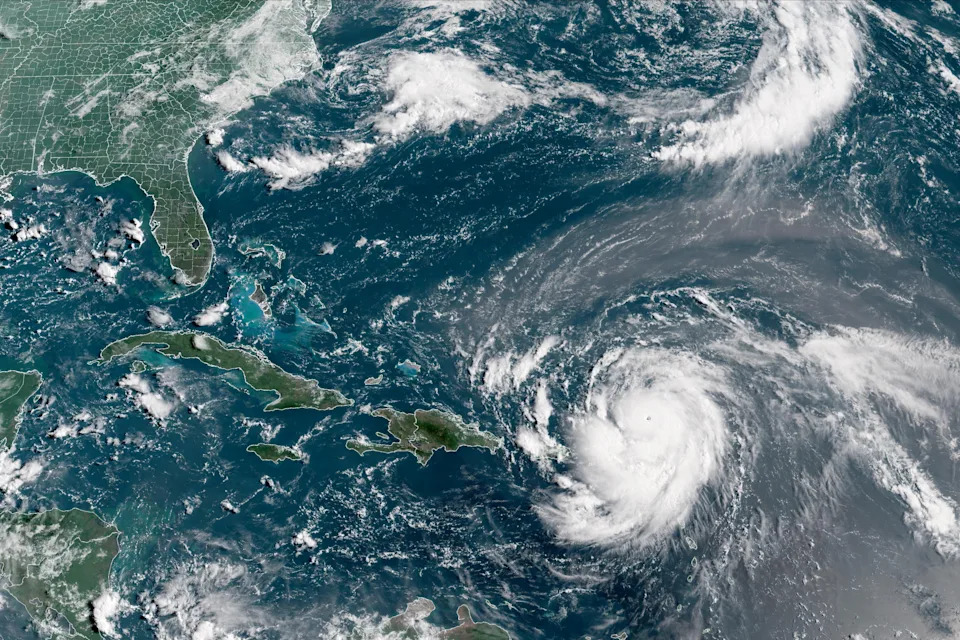A “jet streak” caused by Hurricane Erin is forecast to bring a “big change” to the UK’s weather next week, the Met Office has said.
The category two storm has brought strong winds and possible life-threatening floods to the Caribbean and east coast of the US, prompting evacuations and the closure of beaches.
While it is not forecast to make landfall in the US, the remnants of the hurricane could be seen in the UK by next week, according to the Met Office.
And as it makes its way across the Atlantic this week, Hurricane Erin is set to be picked up by the jet stream, said meteorologist Aidan McGivern. If it does, this would create what is known as a “jet streak”, an area of the jet stream where winds flow more quickly than in surrounding areas.
“Exactly how that manifests, day-to-day, it’s too early to say because there are so many variables involved, not least, how an ex-hurricane is going to interact with a jet stream, and how the jet stream is going to interact with an ex-hurricane,” McGivern said.
“But, what looks most likely is that that ex-hurricane… Fuels the jet stream. The jet stream brings a big change to the UK’s weather into next week, brings an increased likelihood of low pressure, showers, spells of rain and increased wind as well.”

Hurricane Erin moves westward near Puerto Rico in a composite satellite image. (CIRA/NOAA/Reuters)
Met Office meteorologist Marco Petagna said the UK “could well see some heavy rain”, with “uncertainty” kicking in from late on Sunday.
He added: “There’s a risk of some rain developing, a potential that then things will turn increasingly unsettled. We may need some rainfall warnings further down the line, but it’s too early to say.”
Met Office downplays 600-mile band of rain
Some media reports, citing weather data from WXCharts, claim the effects of Erin might be felt in the UK in the shape of a rain storm either up to 600 miles long hitting the country on 28 August.
The reports claim it will bring heavy rainfall to cities such as Belfast, Glasgow, Birmingham, London and Manchester, with Cardiff and Bristol being particularly badly affected.
But the Met Office told Yahoo News UK that an accurate forecast is too difficult to predict this far in advance.
A spokesperson said the date reported when the rain storm could hit “is a way away and weather forecasts become clearer closer to the time”.
BBC meteorologist Simon King also said that the low-pressure system – now over 3,000 miles away – won’t bring extreme weather as it is “physically impossible”.

Signs of early autumn as fallen leaves surround a park in north London on Monday 18 August. (Alamy)
He explained: “Rain doesn’t fall in a continuous sheet stretching for hundreds of miles so there’ll be no ‘wall of rain’ to come with it either.”
While Erin is unlikely to bring extreme weather, King does concede that it could result in wet and windy weather in the UK from the middle of next week.
In its long-range forecast for Friday 22 August to Sunday 31 August, the Met Office says the beginning of this period will be marked by fine and dry weather.
However, it says: “This will be increasingly eroded from the west as frontal systems start to move in from the Atlantic through the weekend, leading to more changeable conditions.”
In addition, a deep area of low pressure is likely in the North Atlantic Ocean because of Hurricane Erin.
The forecast says: “The changeable period will likely continue through the last week of August, especially in the north and west, with a small chance of widely wetter and windier weather developing.”
What about this week?
Following last week’s fourth heatwave of the summer, the rest of this week is set to remain largely dry, following a warm start.
Sunday’s highest temperature was 27.7C in Somerset, while West Sussex and Inverness, Scotland, also reached 27C.
Maximum temperatures are expected to fall to 24C by Wednesday and Thursday, the Met Office said, but could go back up to the high 20s again by the weekend, with a risk of rain in the far west on Sunday.
How accurate are weather forecasts?
The Met Office says that thanks to technology, its four-day forecast is now just as accurate as its one-day forecast was 30 years ago.
It uses its Numerical Weather Prediction (NWP) model for its forecasts, verified by the World Meteorological Organisation (WMO).

Walkers head towards Freshwater Beach Holiday Park at Burton Bradstock on the Dorset Jurassic Coast on Sunday. (Alamy)
The Met Office says that in the past 12 months that 92% of its three-hourly temperature forecasts – given between three to seven days ahead of time – have been accurate to within either 2°C above or below on the current day.
However, it said that because weather is a “chaotic” system, the slightest shift in conditions can lead to inaccuracies in predicting what is to come, meaning it is better to rely on a number of forecast models as opposed to just one.
